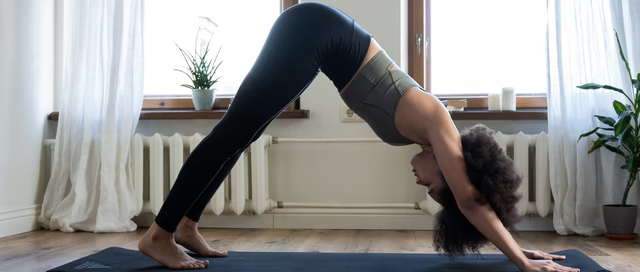
The health benefits of stretching every day
Peer reviewed by Dr Sarah Jarvis MBE, FRCGPLast updated by Georgia GallantLast updated 15 Feb 2019
We all know that the benefits of stretching before and after working out - it helps prevent injury and eases muscle soreness, but what about making stretching a part of your routine every day? Not including a sluggish yawn-and-stretch as you get out of bed!
In this article:
Continue reading below
Why should we stretch everyday?
Our modern lifestyle of sitting down for lengthy periods of time - be it at your desk or bingeing your favourite Netflix show - is putting us at higher risk of developing type 2 diabetes, ruining our posture and tightening our hip flexor muscles. We asked experts to share their opinion on daily stretching and the benefits of stretching for your overall health.
Is stretching good for you?
The ill effects of sitting down all day are becoming a regular news occurrence, and it's not all scaremongering, physiotherapist and spokesperson for the Manchester Institute of Health & Performance (MIHP), Jon Smith, confirms.
"There are clear links between this and general health disorders such as type 2 diabetes, obesity and even increased risk of bowel illnesses," he points out.
While we may not be able to avoid the trap of modern office culture, there are things we can do to help. If you are stuck behind a desk all day, personal trainer Laura Williams suggests that the benefits of stretching out your hamstrings and hip flexors include preventing tightness in the hips and lower back.
Continue reading below
How to stretch your hamstrings
One of the most simple ways to stretch your hamstrings is to bend down and try touching your toes without bending your knees. This can also be done sitting up, legs straight out in front of you. Hold this for 8-10 seconds.
How to stretch your hips
A common hip stretch is a 'lunging stretch'. To do this, kneel upright on your left leg (as if you're standing upright but with your left knee, shin and front of ankle flat on the floor). Place your right foot flat on the floor in front of you so that your knee is at a right angle. Then lean forward and extend your left leg behind you, straightening out your left hip. Try to squeeze your buttocks as you do this to make the stretch deeper. Again, try to hold for ten or so seconds before switching legs.
These are 'static stretches', as opposed to 'dynamic stretches', meaning that you hold the pose for 10 or more seconds while motionless.
Continue reading below
What is dynamic stretching?
Williams says that: "You may be better off stretching out the hip and leg muscle groups with dynamic stretches, which use a range of movement to increase flexibility, as well as boosting blood flow to the area."
A benefit of dynamic stretching is that it will activate the muscles as you move positions during the stretch. For example, you can make a lunging hip stretch more dynamic by adding a 'twist', whereby you twist your torso to the right when you're kneeling on your left leg and leaning forward, extending your right arm towards the ceiling and left arm towards your right toes. Switch legs and repeat on the other side.
According to the UK's NHS, excessive sitting can also slow down the metabolism and may cause weaker muscles and bones, which is hardly surprising. Its Start Active, Stay Active initiative aims to get us all moving more through short bursts of activity for just one or two minutes a day to help combat the negative effects of inactivity. Seems easy, right?
Patient picks for Exercise and physical activity
Should you stretch every day?
We all know the benefits of exercise; however, life constraints, disability or injury can sometimes hold us back. If you're not always able to squeeze in your recommended 150 minutes a week, here's where the benefits of stretching really shine. All it takes is 5-10 minutes a day at a time that suits you.
Try getting up five minutes earlier in the mornings to go through a few deep stretches; waking up your muscles and giving yourself some mental space to get ready for the day. According to Williams, stretching in the morning is particularly useful "if you're prone to sleeping in positions that cause or aggravate neck or back pain".
"In which case," she continues, "some simple shoulder and neck stretches could help you ease out any night-time-induced stiffness."
How to stretch your neck
Stretching your neck couldn't be easier. Face forward, back straight and shoulders squared. Slowly tilt your neck down towards your chest and hold for 10-15 seconds. Repeat this by facing forwards and tilting your neck to the left, then the right. Try to get your ear touching your shoulder.
How to stretch your shoulders
Try a simple cross-body shoulder stretch by standing straight, feet shoulder width apart. Bring your left arm across your body, keeping it straight, with your right hand holding it above the elbow. Hold this for 10-15 seconds then repeat with the other arm.
Everyday stretches
If you're not an early bird, try going through some stretches when you get to your desk in the morning (yes, you may have to endure some strange looks from colleagues), or take a stroll to a nearby park in your lunch hour.
A recent study has shown the benefits of short bursts of activity.
"Breaking up your deskbound day with short walks, replacing the lift with the stairs and stretching out for just a couple of minutes will go a long way," suggests Williams.
Taking a few minutes to decompress and stretch in the evenings will ease muscle tightness built up throughout the day, and stretching before bed may help you to relax.
More benefits of stretching
If that wasn't enough to convince you, here's a few more benefits of stretching everday:
Reduced pain
Spending long periods of time seated can tighten up hip flexors and hamstrings, eventually affecting your spine health.
"Stretching these muscles can really help to both prevent and alleviate back pain," reveals Williams.
Increased flexibility and mobility
As we age, our range of flexibility and mobility can decrease, making it hard to complete daily tasks. Smith advises starting the day with stretching exercises to combat the pain and stiffness felt after waking up, particularly as you get older.
Stretching can improve your quality of life if you suffer from joint pain, but Williams suggests always working within a comfortable range of movement when completing mobility-based stretching exercises.
Additionally, pregnancy can often cause pain around the buttocks and pelvis. Stretching tight muscles around these areas can help, but remain cautious: "There can be a loss of stability and mobility in the area due to the presence of the pregnancy hormone relaxin," points out Williams.
Improved posture
Smith notes that smartphone use shortens, tightens and weakens muscles, due to prolonged sitting posture and neck position, causing joint issues.
"It is important to counter this effect with regular movement every 20-30 minutes to stretch and move in the opposite direction," he suggests.
Stretching the muscles in your chest can also help alleviate back pain and bring your shoulders back into alignment.
To do this, stand up straight with your feet shoulder width apart. Interlock your fingers behind your back then slowly lift upwards. This should pull your shoulder blades together, thus stretching your chest muscles.
Always remember to breathe deeply while stretching.
If you have chronic back pain, you may be able to request a standing desk from your employer.
Decreased chance of injury
"Maintaining good joint mobility and flexible muscles will also help you avoid injuries," notes Smith. Stretching regularly means our muscles are able to travel through a greater range of motion. This, in turn, will reduce delayed-onset muscle stiffness (DOMS) after exercising.
If you want to get more out of your stretching time, consider using a foam roller to aid muscle massage.
Stress management
Stretching can also be used as a stress management tool and anxiety relief when paired with deep rhythmic breathing exercises. Use it as a form of mindful meditation; set aside a designated time of day that you have all to yourself.
You can find many useful resources online for different stretching exercises, including the Patient YouTube channel playlist. However, Smith recommends that you always consult your local physiotherapist for more personal advice.
Article History
The information on this page is written and peer reviewed by qualified clinicians.
15 Feb 2019 | Latest version

Feeling unwell?
Assess your symptoms online for free
